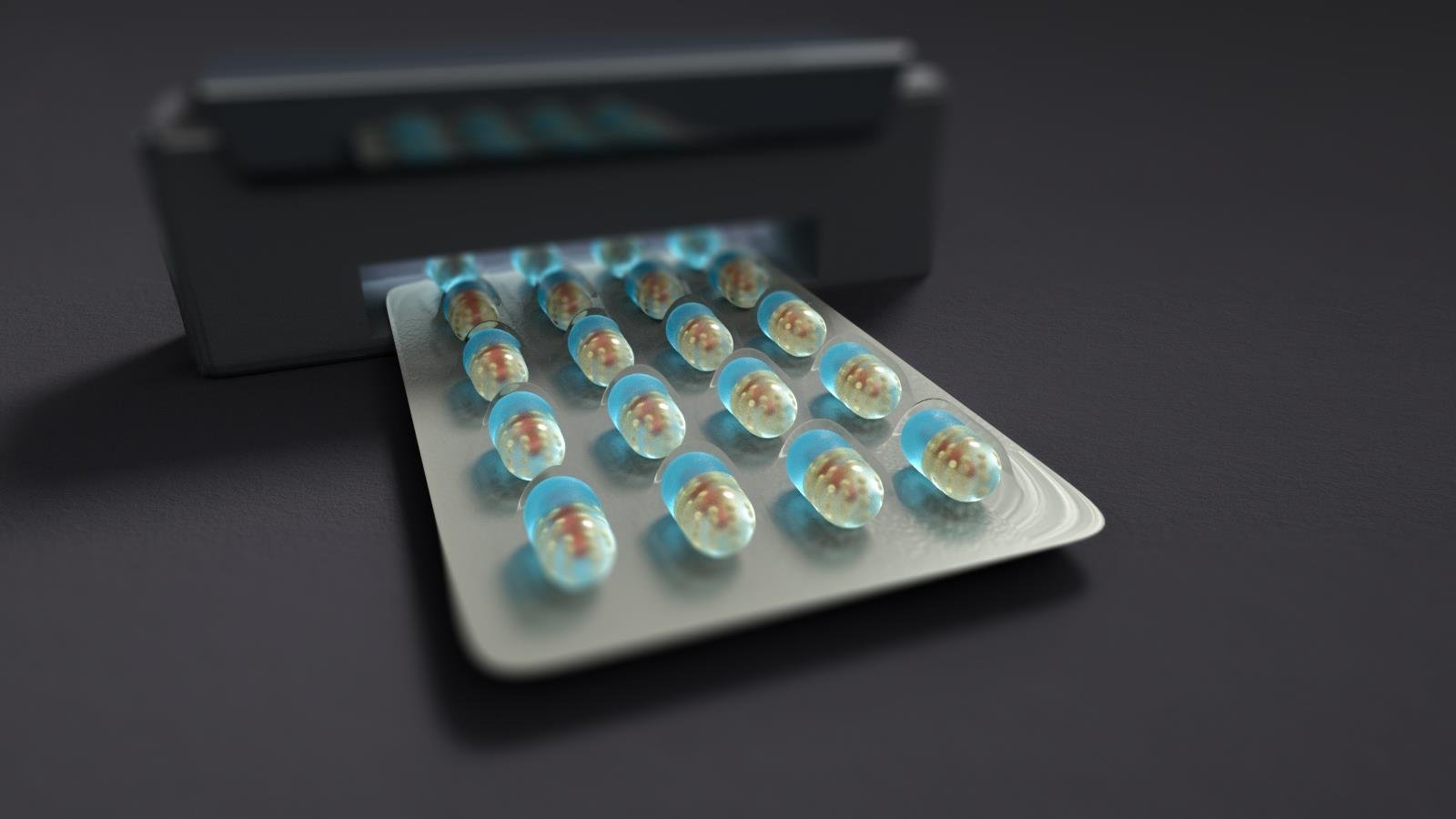
image credit- shutterstock
As the pharmaceutical industry moves away from mass production towards a more personalised model, 3D printing of drugs has the potential to revolutionise the industry.
The first 3D-printed pharmaceutical drug – Spritam (a levetiracetam tablet) by US’ Aprecia Pharmaceuticals – was approved by the US Food and Drug Administration (US FDA) in 2015. Spritam treats epilepsy symptoms. Since then, the segment has seen a flurry of activities and interest. The Global 3D printed drugs market is expected to grow at a CAGR of 15.2 per cent from 2021-2027 to reach $2,064.8 million by 2027, according to UnivDatos Market Insights.
What are the benefits?
Personalised medicines is the most obvious application of 3D printing. Sharing more on 3D printing Dr Alice Melocchi, Co-Founder and CSO, Multiply Labs, US said “One of the main advantages of 3D printing techniques in the context of pharmaceutics is the possibility to personalise the drug products based on the patients needs. By way of example, this entails type and dosage of the drug loaded as well as excipient selection, but would also extend to the design of the drug products and the patient-specific release profiles to be attained.” .
Multiply Labs helps pharmaceutical companies produce drugs with its robotic manufacturing platform. Its cloud-controlled robots are designed to autonomously manufacture small batches of personalised, multi-compartment capsules.
Recent supply chain challenges and demand for worldwide stocks has also seen renewed interest in 3D printing. It helps overcome supply chain issues and provide stability in supply chains – seen as an issue in the recent pandemic.
“By enabling pharmacies to 3D print drugs, we could potentially de-risk the supply chain as well as cut costs of drug manufacturing and distribution. 3D printing offers additional manufacturing processes and potentially new, safer, and cost-effective ways of delivering drugs, such as the bio-availability of drug compounds. It also theoretically reinvents the supply chain where drugs can be made onsite at the pharmacy, which could cost much less than the mass manufacturing of drugs at major warehouses. Warehouses are expensive to build and operate, and the e-pedigree to maintain supply chain safety from the manufacturing plant to the distribution center to the patient is quite costly,” said Kevin Coker, CEO of Proxima Clinical Research, a US based contract research organisation guiding emerging MedTech, biotech, pharmaceutical and device companies through regulatory, quality and clinical development to bring their inventions to market.
Unlike the equipment in drug manufacturing plants, the equipment for 3D-printed drugs is much smaller and can print in small batches. There’s no wastage of active or chemical ingredients, offering a more sustainable way to produce drugs.
“3D-printed drugs also cut down on the carbon footprint created from moving the supply chain around the world. Currently, a lot of active ingredients come from China, where they then would go to another country, like India, to be put in pill form. From there, it would then move somewhere else to get repackaged. 3D printing drugs have the power to eliminate these steps in the supply chain with the ability to manufacture the drugs where they’re actually being used,” said Susan L Lang, founder and CEO, XIL Health, USA, a leading strategic analytics and technology company in the drug economics space.
Also, with 3D printing, fast novel dosage form production can reduce time and costs in clinical trials.
“On the other hand, 3D printing could also be employed as a rapid prototyping tool. For example, it could be used for real-time manufacturing of samples to be tested to assess the validity of an experimental drug delivery system. This approach can drastically reduce R&D time and costs, especially in comparison to more traditional and complex manufacturing approaches leaning on mass-production,” added Dr Melocchi.
Challenges in printing pills
3D printing has the potential to revolutionise the pharmaceutical manufacturing industry, however, few 3D-printed products have been approved since the first in 2015.
“At the moment the industry is going from proof of concept studies towards industrial applications. The conservative pharma industry is hesitant to change to a new technology, as it could potentially present more unknown risks in all fields of drug development and registration,” said Korinde van den Heuvel, Senior Product Developer, DFE Pharma, Germany. DFE Pharma develops, produces and supplies excipients for use in oral solid dose and dry powder inhalation.
A new technology takes time to build real-world evidence to prove its capabilities. Right now, Spritam is serving as a proof of concept which will help other molecules get approved quicker for 3D printing.
“As far as regulatory hurdles go, the issues are not around FDA approval, but rather, distributing technologies. The bigger challenge is whether the law is able to keep up with the technology as there are a lot of criminal activities within the drug supply chain we have to be careful about. Legal challenges aside, I think FDA approval will be much quicker now that Spritam has been approved,” added Lang.
Pharma is a heavily regulated industry. It’s easy to approve a manufacturing facility which mass produces the drugs rather than approve all the facilities where a drug can be printed.
“Bringing a new medicine to market is costly and time consuming. With a novel, disruptive technology like 3D printing for personalised medicine it is even harder as standard regulatory routes cannot be used. New regulation is currently being written by leading authorities for this field, once published the field will be able to advance more rapidly. An example of this is the point-of-care legislation being brought in by the MHRA, UK,” said Dr Anna Worsley, Director of Innovation, FabRx Ltd, UK.
Since its inception in 2014, the startup has become one of the leaders in 3D printing drug manufacturing space. In 2020, the firm launched, M3DIMAKER, world’s first pharmaceutical 3D printer for personalised medicines.
Spritam is 3D printed but in a mass manufactured scale and does not offer personalised dosage forms. This means it uses 3D printing in a less disruptive manner and it can be added to the market using standard regulatory routes.
Dr Melocchi explains this in detail, “Spritam is the only 3D printed drug currently already on the market. It is a fast-dissolving tablet containing levetiracetam, manufactured by a 3D printing technique called binder jetting. This technique was developed in the late 1980s in the labs of the Massachusetts Institute of Technology (MIT, US) and then fully redesigned by Aprecia Pharmaceuticals. This 3D printing technique was selected to give a specific quality attribute to the product, i.e. an extremely rapid disintegration, which increases the dissolution rate and improves the bioavailability of the drug, enabling better treatment of epileptic patients suffering from seizures. Although Spritam is available on the market in a few different dosages, all the units belonging to a single batch contain the same drug strength. Therefore, it may not be considered a personalised medicine. Indeed, it was approved by the FDA in 2015 through a traditional regulatory pathway, after years of research aimed at making the technology suitable for mass manufacturing. Therefore, the idea of using 3D printing for the manufacturing of personalised drug products still represents a challenge due to difficulties in identifying a suitable regulatory strategy to guarantee the quality standards of final products, which would be, by definition, all different from one another.”
Future of 3D printed drugs
3D printing could revolutionise personalised medicine, impact drug distribution and tackle sustainability issues.
“By putting a 3D printing centre close to major hospitals and distribution centres around the world, drugs can be manufactured on the spot and as needed. Over time, 3D printers will continue to get smaller, eliminating waste and bettering quality control. By shortening the supply chain, there will be less of a worry of contamination and fakes being introduced in the cycle,” said Susan.
Echoing similar sentiments, Dr Worsley said, “In the future we will see desktop 3D printers, like our M3DIMKAER, in hospitals and pharmacies around the world, personalising formulations in many different ways, including dose, colour, flavour and drug combinations. This will help patients adhere to their treatment plan as well as reduce the costs and risks involved with current compounding techniques. This will start happening in the next few years for more troublesome treatment pathways as clinical trials are carried out and regulatory authorities start to publish legislation for personalised medicine approaches, such as 3D printing.’’
It’s a long way before personalised 3D printed products can become widely available. Challenges are not limited to manufacturing, but also include significant regulatory hurdles. In that regard, the USFDA is working with the National Institute of Standards and Technology to create guidelines for 3D pill printing.
“Understanding which regulatory paths apply to the different phases of the overall process (e.g. approval of starting materials, printers, software, control tools, environment, quality control) is probably the next-to-face challenge. In this respect, the effective collaboration between experts belonging to complementary fields such as academia, regulatory affairs, and industry is essential to achieve translational goals,” said Dr Melocchi
A centralised database uniting industry, academia and innovators would allow for the collaboration and pooling of knowledge within the industry. This repository would support better patient care and provide an invaluable tool to investigators.
Overall, 3D printing has the potential to revolutionise the drug manufacturing. However, we will have to wait and see whether the challenges facing the industry can be overcome to allow the technology to reach its full therapeutic potential.
Ayesha Siddiqui



